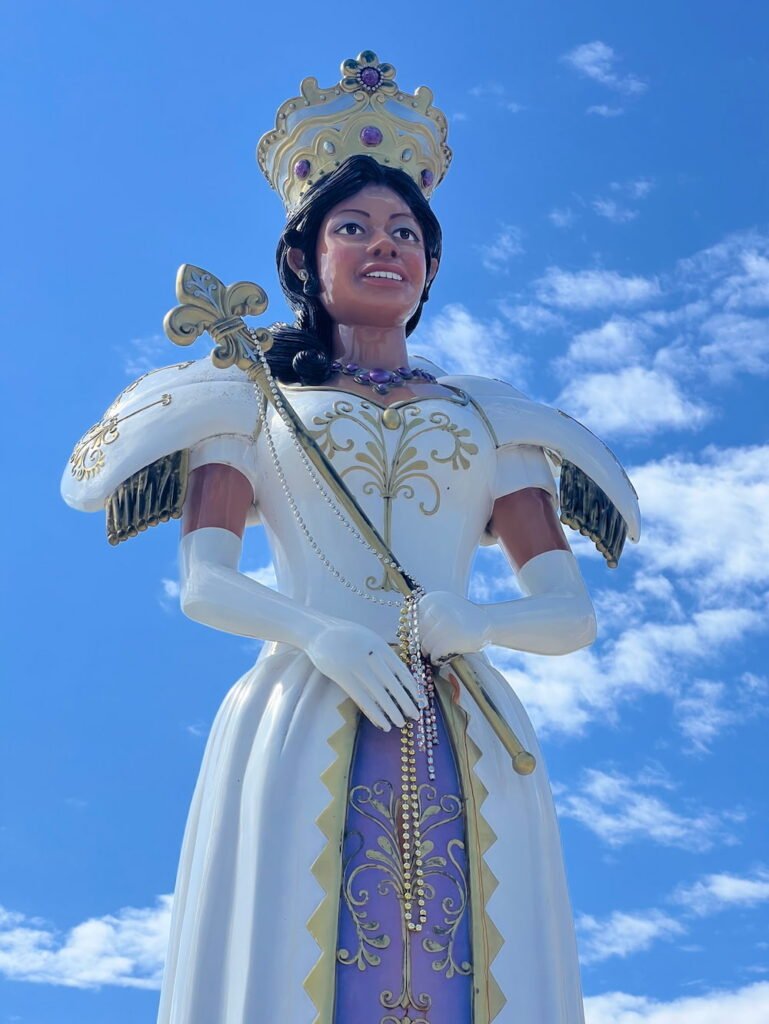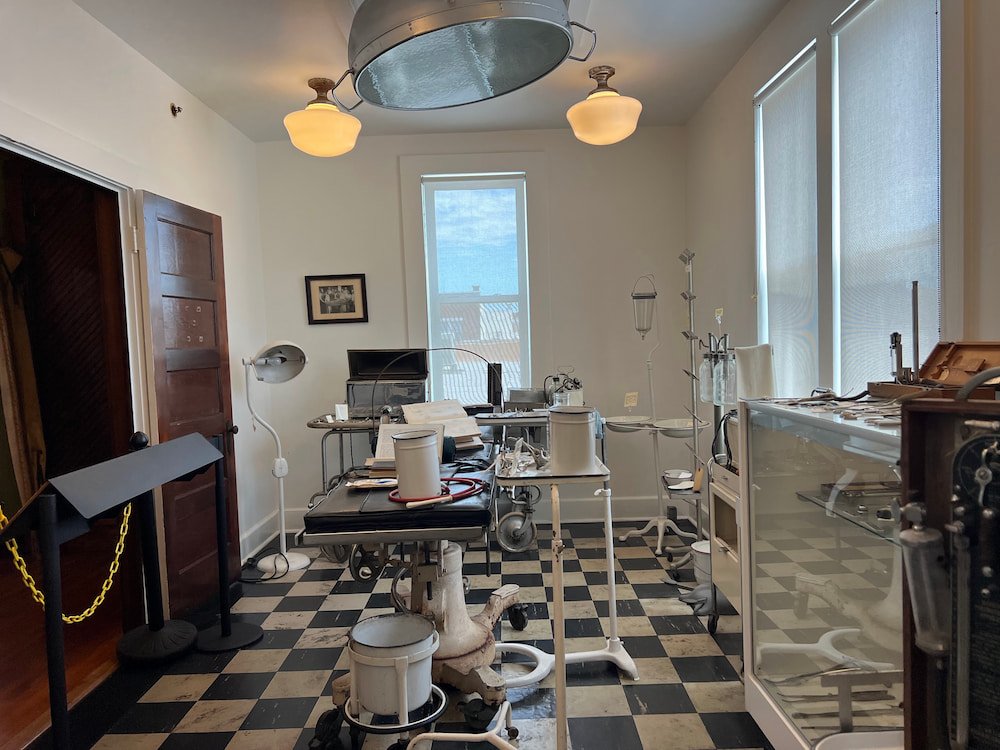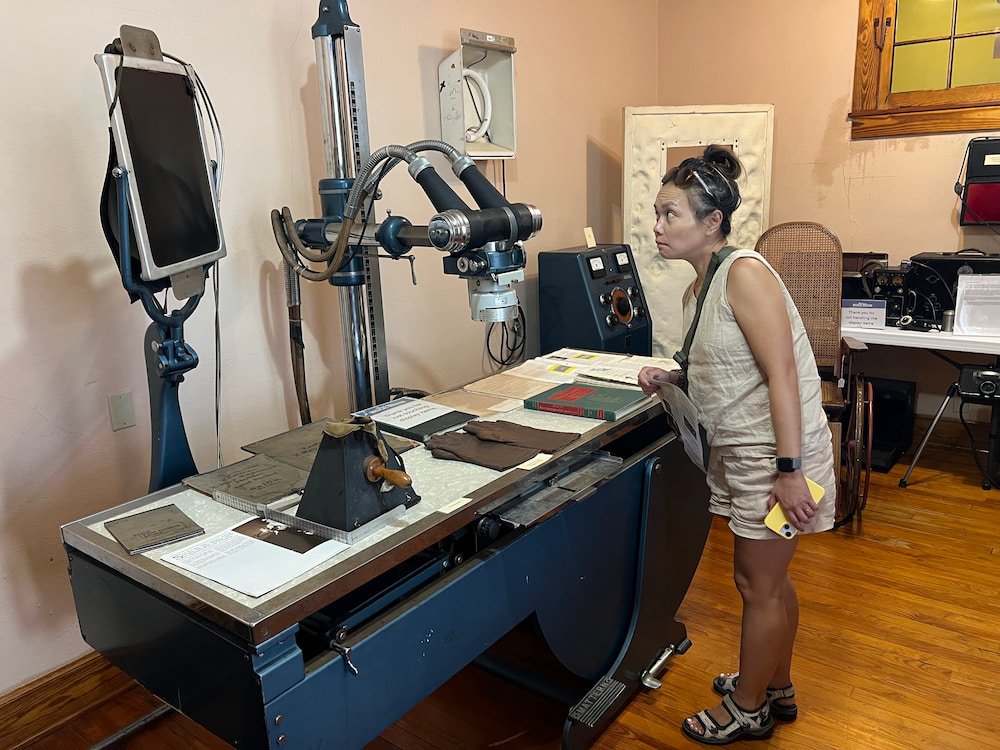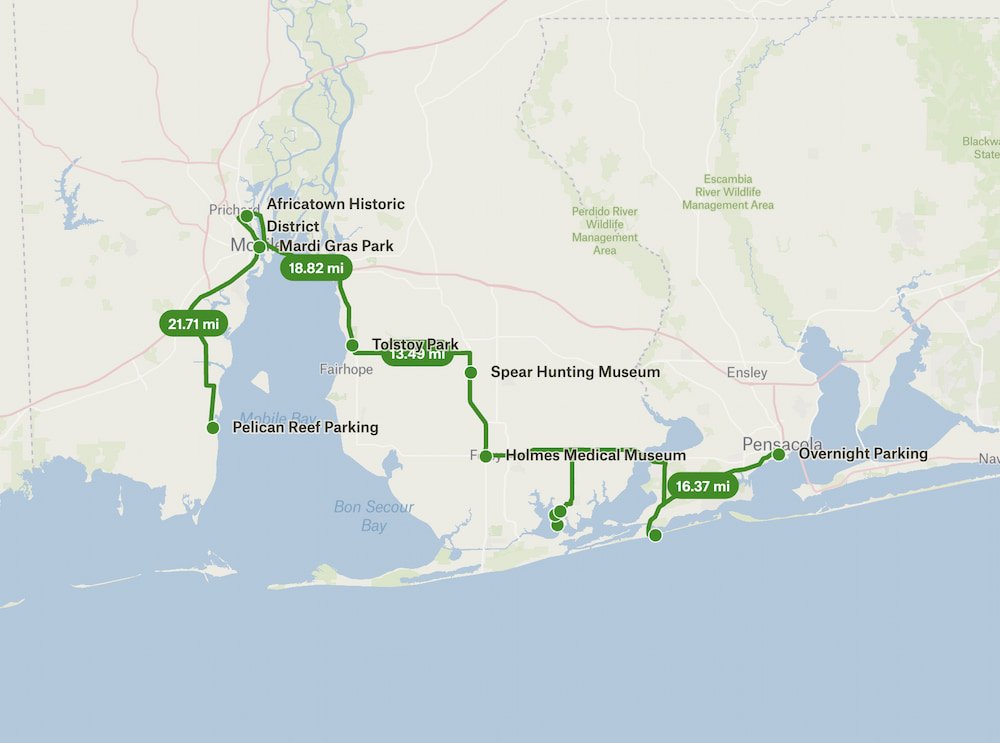We'd stayed overnight next to a shrimping boat marina, but surprisingly it wasn't too busy in the morning (unless most shrimpers had left well before dawn and we'd just slept through it). We left the rural setting near Dauphin Island in Alabama, arriving soon in Mobile, a port city that's the second most-populous city in the state.
Home of the Mardi Gras
There's some funky architecture in Mobile, including the tallest skyscraper in the city, the RSA Battle House Tower, a postmodern building with a recognizable, illuminated crown and spire that looks reminiscent of the Chrysler Building in New York, except that the top of the spire is see through.

One fun fact about Mobile that we didn't know, is that it's the birthplace of the Mardi Gras in the US! While New Orleans gets all the attention, French settlers had the first Mardi Gras celebration in Mobile in 1703, 15 years before New Orleans was even founded. To commemorate this, there are many life-sized statues near the Historic Museum of Mobile, including past kings and queens, musical performers and other historic figures.



We didn't go inside, but we saw the impressive Fort Condé nearby, built in 1723 by French explorers (most of it is a replica of the original). Fort Condé had different names depending on the various colonial powers, including Fort Louis, Fort Charlotte, and Fuerta Carlota. One of the historic events was that Spain (an ally of the US at the time), declared war on Great Britain in 1779. In 1780, the governor of Spanish Louisiana led the attack against the British, which included a siege of Fort Charlotte (Condé) and led to the British threat being removed from the Gulf of Mexico.


Africatown
Outside of downtown Mobile is Africatown, a community that was founded by the survivors of the last known slave ship, the Clotilda, which arrived in the US in 1860. The former slaves bought land and built the settlement, and while at its peak there were about 12,000 residents here, the number has decreased to less than 2,000 people today. Quite a few of the homes looked really rundown, so we're not sure if these have been abandoned.


In Africatown, there's a visitor center and museum, as well the Union Baptist Church, which was developed in 1869 and still operates today. At the front, there's a bust of Cudjoe "Kazoola" Lewis, the last known survivor of the Clotilda who died in 1935. He is buried at the Old Plateau Cemetery across the road, which was established in 1876 and is the final resting place of Africans, African Americans, and a Buffalo Soldier. The northern part of the cemetery is the older section, which is the burial place of many of the slaves who were on the Clotilda.
Goin' Shrimpin'
Leaving Mobile, we crossed a bridge that spanned the Mobile Bay, but as we'd seen so many shrimping boats in the last day, really had a hankering to try some shrimp! The brown shrimp is the state's crustacean, so we couldn't leave without trying it. Across the bridge in the town of Daphne is Market by the Bay, a highly rated restaurant serving Cajun seafood specialties including gumbo and po'boys. We arrived just before they opened at 11am--it was early for lunch, but we could eat!

We ordered half a po'boy sandwich (blackened shrimp on one, fried shimp for the other), and a cup of gumbo each. Lisette also wanted to try the southern speciality of fried okra, so we got that as well as a side. The food was delicious! Definitely a huge portion of fried okra between the both of us, and Lisette had to have her food for lunch and dinner (serving portions are generous!), but we're glad that we got to eat this, particularly as we didn't end up ordering gumbo or po'boy sandwiches when we were in New Orleans recently. We also received 6(!) packets of crackers that we didn't even eat, we guess to go with the gumbo, which we'll save up to eat with some dip or something. Despite arriving there early, there was already a couple seated when Lisette walked in, and as she was walking out with her food, another couple was entering. A good sign of the food being delicious and fresh!

Tolstoy Park and the Holmes Medical Museum
We briefly stopped at Tolstoy Park, the historic home of a man named Henry Stuart, who was diagnosed with tuberculosis while living in Idaho, and advised to move to a warmer climate. As you do, he built a small and round, hurricane-resistant home, only 14 feet in diameter, which he lived in isolation. We peeked down into the windows as it's a curiously tiny home, with this and a large oak tree all that remain of his estate. Today, it's a bit of an oddity, sitting awkwardly in a parking lot that's been built around it, with real estate offices next to it.

One of the most fascinating trees we've seen in Alabama looks like it's covered in spiderwebs. It turns out that these webs are not created by spiders, but by fall webworms, which feast on persimmon, pecan and other hardwood trees, creating huge silken webs high up in the branches. Fascinating stuff!
In the town of Foley in Baldwin County, is the Holmes Medical Museum, a free (donations-based) museum that was once the county's first hospital, which operated from 1936-1958. It was established by Dr. W.C. "Buddy" Holmes, and his wife, Philomene, in order of his dad. The hospital played a vital role in serving the entire community (Black patients had a separate waiting room), until it outgrew this location and moved to bigger premises.




The museum today is a two-story building, with a self-guided tour showing all sorts of medical artifacts, including surgical instruments, medicine bottles (interesting to see how the medicine was also concocted in a bit of a science lab upstairs), obstetrical instruments, old X-ray machines, operating rooms, as well as the doctor's office, nurse's living quarters onsite, kitchen and living room. It was interesting to see the wide array of artifacts here, including a lot of items that are no longer used by doctors today, such as an octagon brass bloodletting device and a Spectro-Chrome (only 4 exist are still known to exist--it was believed color waves could cure everything except for broken bones and the pain of childbirth).


Also in Baldwin County, tucked away within dense woodlands, is Bamahenge, structures made out of fiberglass that are meant to resemble Stonehenge in the UK. Since they're made out of relatively light material, it's a full-scale replica. This is one of many (at least 5!) other Stonehenge-inspired structures we've already seen on this trip: we've visited Ryanhenge in Nevada all the way back on day 4, Truckhenge in Kansas on day 138, a Stonehenge Jr. in Wichita on day 139, Cahokia "Woodhenge" near St. Louis on day 165, Kentucky Stonehenge on day 187 (there's also "Carhenge" in Nebraska, which we didn't visit as it was too out of the way for us to get to).
Orange Beach
Our final stop in Alabama was Orange Beach, a small city on the Gulf Coast, where we visited Barber Marina, which was devoid of people, but had a lot of nice and expensive yachts and other vessels docked. At the marina is a quirky sculpture in the water, called Lady in the Lake, which is of a young woman that looks like she's floating in the water, with only her head and her knees visible. It's a fun sculpture as it just seems like she's chilling as if the marina is a bathtub, and walking around her we got a lot of different perspectives.


From here, we wrapped up our visit to Alabama, entering state #32: Florida! We wanted to visit Johnson Beach in the Perdido Key area, which is a national park (and we'd be using our national parks pass for the first time in a long time)! Unfortunately we were turned away as there's a length limit that's now imposed, and we were too long to enter. So then we tried to visit the Pensacola Lighthouse & Maritime Museum, but it turns out it's within a military base (Pensacola is home to a naval air station and the US Navy Blue Angels), which was going to be a lot of extra work to get through. Pensacola is a vacation hot spot and even though the summer holidays are over, RV parks were well over $100 a night, so it seemed we wouldn't be staying here for long.

Fortunately, we found a place to park overnight next to Corinne Jones Park, a neighborhood park with a big fountain in the middle of the manmade lake, with trails around it for people to walk their dogs or go jogging. It seemed like a quiet and safe area, so we spent the night here.
Route Map

